Wrapping & Binding: Summer 2024 Journal, Out Now!
July 15, 2024
Surface Design Association is excited to announce Wrapping & Binding, our Summer 2024 edition of Surface Design Journal. “Wrapping and binding practices have been used to imbue objects or individuals with meaning by humans throughout history. Drawing inspiration from the traditions of various cultures—the handfasting or marriage binding customs of ancient Ireland, the Furoshiki or knotting practices of Japan, or the coiling of the tefillin by the Jewish faithful—the contemporary artists in this issue engage wrapping and binding as both process and product. Situated within these related techniques are the lived experiences of displacement, migration and adaptation: timely themes our contributors explore in-depth as we celebrate the myriad approaches to wrapping and binding.” –Elizabeth Kozlowski, Surface Design Journal Editor
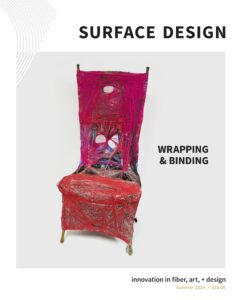
Here’s a preview of what you’ll discover:
Islands Entangled: Tracing Kuzu in the Pacific by Rebecca Maria Goldschmidt: “Kuzu has guided me to rural Japan, Okinawa, Hawaiʻi and my ancestral home in the Philippines to understand the interconnectedness between our island communities. I see kuzu as a metaphor for entanglement in the Pacific: our lives shaped by both the histories of colonial expansion and war, as well as peoples’ sprawling movements for Peace. By reimagining our relationship towards plants that are ignored or portrayed as ‘aggressive’ or ‘useless’ weeds, we recreate our own worlds…My work of (re)mapping kuzu is an effort to weave a sense of place that is both informed by, and deeply resistant to, militarism.”
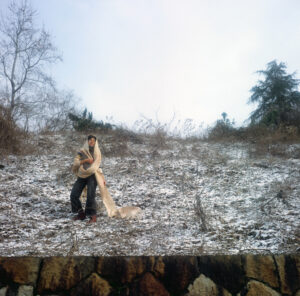
Rebecca Maria Goldschmidt and kuzufu weaving in the kuzu patch, 2023. Photo: Xiang Liu.
Wrapping, Binding And Disability Aesthetics: Art from Creative Growth, Creativity Explored, and NIAD by Frances Fleetwood: “There are many common threads that weave together the works by these artists and reference Disability Aesthetics: the use of found objects, hiding objects within artworks, intuitive ways of working, the focus on repetition and process, the physicality of wrapping and its relationship to the body, and the tactility of materials. Of course, these can all be present in works made by non-disabled artists. However, viewing these artworks under the umbrella of Disability Aesthetics reminds us that disability is constantly present in contemporary art, in more subtle and complex ways than viewers might imagine.”
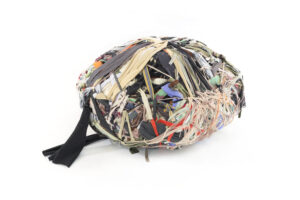
Judith Scott, Untitled, 2002. Mixed media, 26 x 11 x 26 inches. Photo courtesy of Creative Growth.
The Wrapping and the Wrapped: The Works of Hwajin Oh and Yesun Shin by Bogil Lee: “The act of wrapping generates various ideas in pairs: inside and outside, intestines and skin, body and clothing, and so on. These ideas only work in relationships. Inside does not stand without outside, nor does outside stand without inside. In the act of wrapping, it is crucial to look at the relationship between what is wrapping and what is being wrapped, and how this dynamic presents itself as both concept and material. This communication between the wrapped objects and the textiles used for wrapping is exemplified in the works of two Korean artists, Hwajin Oh and Yesun Shin.”
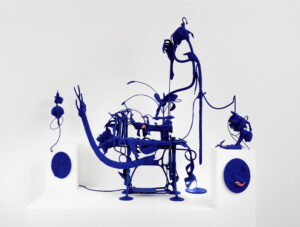
Hwajin Oh, Love Rub like a God, 2018. Machine-sewn wool with stuffing, iron, and mixed media, dimensions vary. Photo: Jaeuk Lee.
Reframing Repair: Wireworking in Slovakia by Kristin L. Tollefson: “I gravitated toward the way the dark wire appeared to draw in space, how it was easy to manipulate, and how accessible it was. I frequented hardware stores to find it, and in the process learned about how gauges related to size, how annealing and work hardening changed the characteristics of the material. It became my medium of choice: portable, malleable and easy to use at the kitchen table that was my studio. But it was the references to wire in Slovakia in Arline Fisch’s Textile Techniques in Metal and Suzanne Slesin and Daniel Rozenstroch’s, Everyday Things: Wire that stimulated my interest, and for thirty years I dreamed of going there.”
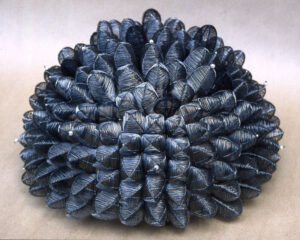
Kristin L. Tollefson, Bright Mound, 2003. Wireworked blackened annealed steel wire with synthetic pearls, 8 x 10 x 10 inches. Photo by the artist.
Exposure: A Gallery Of SDA Members’ Work featuring Sue Cortese, Jennifer Davies, Mona Duggan, Sarah Haskell and Saberah Malik.
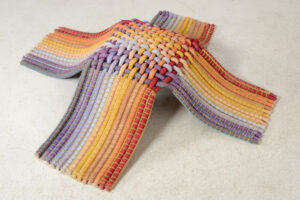
Mona Duggan, Inextricably Entwined IV, 2022. Wrapped, stitched and woven cotton cord, nylon net and wool, 12 x 48 x 48 inches. Photo: James Dewrance Photography.
In The Studio: Life of a Tree by Disha Dhadiwal: “My work is based on the concept of nonviolence. Inspired by the ancient wisdom of Jainism, a religion steeped in the value of ‘Ahimsa,’ meaning without injury, I believe in reducing harm toward the living beings around us, including plants and animals, as much as possible.”
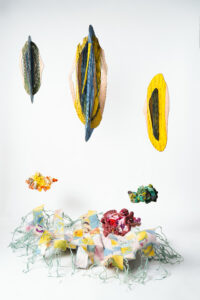
Disha Dhadiwal, Life of a Tree, 2023. Wool and cotton
yarn wrapped around laser-cut wooden panels and suspended with wire, sewn cotton fabric and upcycled fabric scraps dyed with indigo, gardenia, hibiscus, madder, and indigo pigment, 132 x 61.5 inches. Photo: Sawani Chaudhary.
In The Studio: Exploring Impermanence by Bethany Cordero: “Wrapping and binding techniques like weaving, knitting and crochet involve the process of encircling, enveloping and securing materials together. These actions can represent our attempts to comprehend and perhaps grasp at what remains of our existence in the face of life’s impermanence. We have an instinct to protect and shelter what is precious to us. Just as we wrap a fragile object in a blanket or bind it with twine to keep it safe, we seek to safeguard the fleeting moments and memories that define our lives.”
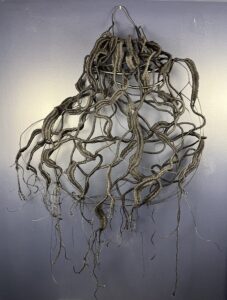
Bethany Cordero, Lineage, 2024. Woven jute around welded steel armature with onyx lacquer, 48 x 35 x 10.5 inches. Photo by the artist.
In The Studio: Between the Lines: Wrapping as Art-Making, Introspection and Decolonisation by Celline Mercado: “Recently, I have been exploring my diasporic identity in relation to colonial trauma. By laboriously wrapping domestic items such as bed frames, chairs and lamps in soft fibre and suspending them in the air, I have been creating sculptural installations to evoke the uncanny in an attempt to encapsulate my experiences of liminality as a temporary migrant in Australia. I developed this creative methodology after I moved from Manila to Melbourne. In turn, it has led me to start examining how colonial legacies continue to affect the formation of Filipino identity.”

Celline Mercado, Dismantled Bed II (Iteration II), 2024. Bed frame wrapped in acrylic wool, dimensions variable. Photo by the artist.
First Person: Bound and Wrapped Unveiling by Ina Kaur: “I pursue a decolonial practice, seeking to incorporate elements from diverse histories, past events and cultural landscapes. My work aims to reimagine the self no longer bound to the oppressive power of dominant norms. Each iteration critiques social constructs and their complex underlying systems, values and attitudes which contribute toward specific classifications and the formulation of displaced and oppressed bodies. A tapestry of meaning is constructed to invite interpretation and introspection.”
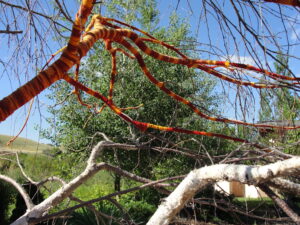
Ina Kaur, Cicatrization, 2010. Wrapped and bound cotton thread on branches, dimensions vary. Photo by the artist.
Informed Source: Performing Without a Performer: The Work of Vincent Tiley’s Rope Paintings by matt lambert: “Despite the broad embrace of interdisciplinary practice, which abandons silos and strict definitions, there are moments when framing work through specificity is crucial. It summons specific histories and cannons, contextualizing but also pushing against and interrogating these ideas. In this vein, Vincent Tiley is very conscious of calling part of his oeuvre of work Rope Paintings. Painting allows the work to engage with concerns of composition, lines and frames… Tiley’s bound and tied paintings are a way to summon a bodily presence without being a representation of a particular body. They question if an object can do the work of performing without a human performer present.”
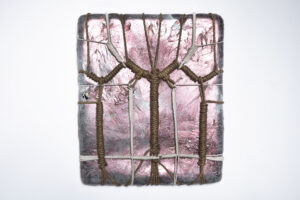
Vincent Tiley, Crushed Orchid II, 2017. Neoprene with foil film, acrylic gloss gel, rope and nail polish over foam 38 x 30 inches. Photo: Fred Attenborough.
Informed Source: with Sarah Zapata by May Howard: “Zapata’s fiberscapes weave ancestral knowledges and visual culture with contemporary materials and methods of construction. Zapata welcomes us into the long continuum of American and Peruvian textile practices; past, present and emerging. Her vision of futurity is one in which tradition, generational wisdom, and contemporaneity coalesce in the binding of threads in space.”
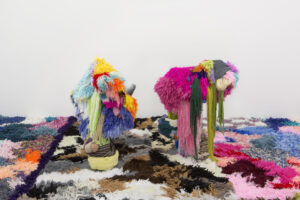
Sarah Zapata, If I Could, 2017. Installation View. Photo: Deli Gallery. Courtesy the artist and Deli Gallery.
In Review: Sonya Clark: We Are Each Other reviewed by Paulette Young: “We Are Each Other is a thought-provoking exhibition, whose title is inspired by a moving poem by Gwendolyn Brooks honoring fellow Black artist, thespian, athlete and activist Paul Robeson. Brooks affirms in her ending verse that, ‘we are each other’s harvest: we are each other’s business: we are each other’s magnitude and bond.’ It is a benediction and a summons to action reinforced by the communal projects celebrated in this show. ”
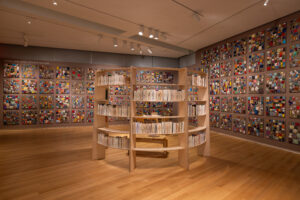
Sonya Clark: We are Each Other, 2024, at the Museum of Arts and Design, New York. Photo: Jenna Bascom. Courtesy of the Museum of Arts and Design.
In Review: Nancy Koenigsberg: Line and Shadow reviewed by Patricia Malarcher: “Koenigsberg’s hand-wrought artworks seamlessly blend a textile sensibility with an industrial material. Varying in scale and density, the basic units of construction are grids formed by looping, knotting or interlacing pliable lengths of wire. The grid’s potential for endless permutations is evident throughout the exhibition.”
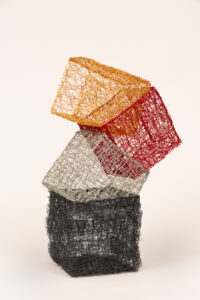
Nancy Koenigsberg, Tumble III, 2023. Woven and sewn steel and coated copper wire, 22.5 x 12.75 x 8 inches. Photo: Josh Nefsky.
Spotlight on Education: The Vulnerable Weavings by Kadi Pajupuu: “Weaving at Pallas is more than just a series of courses; it’s an exhilarating journey into the world of textile design. Once students grasp the fundamentals, they eagerly delve into experimentation, pushing the boundaries of traditional techniques. Wearability is also a key focus. Students strive to create fabrics that are not only visually striking but also wearable. Through ingenious pattern variations, they reduce the necessity for extensive sewing, utilizing warp ends to connect garment parts.”
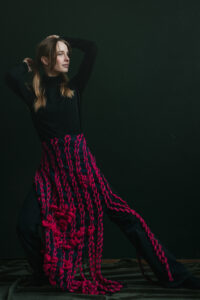
Hanna-Maria Org, STARK, 2024. RailReed-woven special chunky yarn. Photo: Lisette Laanoja. Mode:l Ingemari Randaru.
On Display by Lauren Sinner feature the current exhibitions Refashioning at Hammer Museum, Resonant Earth: Contemporary Perspectives on Land and Body at Moody Center for the Arts, Hereafter at Contemporary Craft and Threaded Visions: Contemporary Weaving from the Collection at The Art Institute of Chicago.
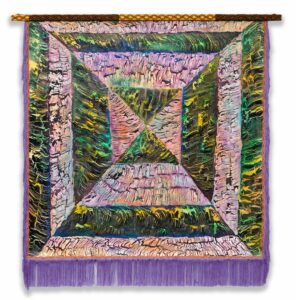
Lisa Alvarado, Spinning Echo, 2023. Acrylic, canvas, fabric and wood, 81.5 x 80.5 inches. Courtesy the artist and Bridget Donahue, New York.
To buy a copy of Wrapping & Binding, go to the SDA Marketplace, or you can check out a free digital sample on our SDA Journal page.
